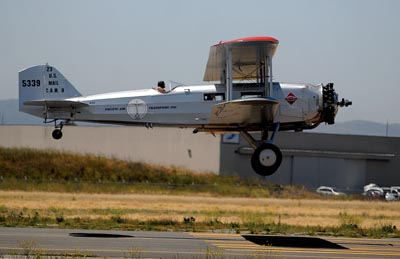
Owners of the Boeing-Stearman Model 75 gathered Friday at the
Hollister Municipal Airport to prepare for an airshow in
Watsonville and see one the only operating Boeing 40
– an old-style mail delivery aircraft – in the world.
HOLLISTER
Owners of the Boeing-Stearman Model 75 gathered Friday at the Hollister Municipal Airport to prepare for an airshow in Watsonville and see one the only operating Boeing 40 – an old-style mail delivery aircraft – in the world.
“It’s a different looking plane,” Byron Roberts said of the Boeing 40.
Roberts, a Hayward-based Boeing Stearman owner, was there to take in the festivities at the airport and then participate in the Watsonville airshow over the weekend.
The Boeing 40 is owned and operated by Addison Pemberton, who operates out of Felts Field in Spokane, Wash., said Byron Roberts, a Hayward-based Stearman owner.
“Last year, he went from the Statue of Liberty to the Golden Gate Bridge,” he said.
The Boeing 40 could hold up to 750 pounds of mail, four passengers and a pilot in an open-air cockpit above. The plane is powered by a 650-horsepower, nine-cylinder Pratt and Whitney radial engine.
At least five Boeing-Stearman Model 75s were at the airport for both the airshow and for their pilots to see the Boeing 40.
One of the pilots, Bill Austin of Concord, was at the airport to see the Boeing 40 and its pilot. Austin’s Stearman was built in 1942 and is painted differently than the usual yellow will be headed to Yountville for Memorial Day festivities.
“I always do a fly-over in Yountville. There is a large veterans home there,” Austin said.
The Stearman was a popular plane in the 1940s and was used by the military for training purposes.
“Most of the World War II pilots learned to fly in these,” Austin said.
The planes were made excellent training vessels because of their durability. Made of a steel tube fuselage with wooden wings covered in fabric and supported by steel wires, the plane was and still remains durable.
“You can go 13 Gs in one of these,” Roberts said.
However, because the military painted these planes yellow and that they were difficult to land, Roberts said they earned the nickname “yellow peril.”
After World War II ended, many of the 10,200 trainers were converted in to crop dusters by removing the front seat that would normally hold a passenger and placing a hopper in there that would hold pesticides or fertilizers.









